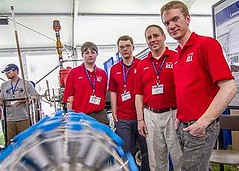 美國環保署日前公佈今年「人群、繁榮和地球獎」(People, Prosperity and the Planet Award,簡稱P3獎)的得主,這個獎項是獎勵以創新方式,面對一些艱難的公衛和環境問題的挑戰,今年獲獎的創新解決方案包括創造更好的生質柴油和家用清潔劑,以及利用3D列印技術製造建築材料。
美國環保署日前公佈今年「人群、繁榮和地球獎」(People, Prosperity and the Planet Award,簡稱P3獎)的得主,這個獎項是獎勵以創新方式,面對一些艱難的公衛和環境問題的挑戰,今年獲獎的創新解決方案包括創造更好的生質柴油和家用清潔劑,以及利用3D列印技術製造建築材料。
七組獲獎的團隊都能獲得高達9萬美元的資金,幫助他們的設計能有進一步的發展,以及隨後可能的上市規畫。
環保署研究和發展辦公室的首席副管理師卡得利(Lek Kadeli)表示,「這項競賽相當重要,能激勵新一代科學家和工程師更佳了解我們世界面臨的複雜環境問題,並藉由創新和創造力更有效地解決問題。」
「P3計畫讓本國的學生有機會將其創意概念運用到現實世界,並以永續發展的方式保護環境。」
前幾屆P3獎的獲獎者有的已成功創業,並在全世界行銷其技術。
環保署的P3獎競賽,在今年4月舉行的第九屆國家永續設計博覽會(Annual National Sustainable Design Expo)上進行評審。今年的獲獎者是:
芝加哥羅耀拉大學(Loyola University Chicago)開發一種更環保的方式,處理以及再利用製造生質柴油產生的副產品。目前製造生質柴油的過程會產生鹽、油和甲醇等廢棄產物,該團隊的設計組合了蒸餾和溼地系統,可以就地處理和再利用污染物,讓製造生質柴油可以符合完全永續發展。
麻州大學羅威爾分校(University of Massachusetts Lowell)利用果皮和藻類,創造出無毒且生物可分解的介面活性劑。大部份介面活性劑是以石油為基礎的化合物,多用於日常用品,例如家用洗滌劑、個人護理產品和工業清潔劑。多數表面活性劑產品屬於生物不可分解,或者會分解成有毒的產物。這個團隊從果皮和藻類合成出更環保的表面活性劑,並分析其效能。
 拉德福大學(Radford University)設計一種天然產生的塗料,讓沙子可以吸收水裡的污染物,例如如砷、鎘和鉛。該設計以腐植酸為基礎,這是能捕捉水污染物的天然化合物。該團隊利用糖類人工合成腐植酸,比目前的生產程序更經濟且有效率。
拉德福大學(Radford University)設計一種天然產生的塗料,讓沙子可以吸收水裡的污染物,例如如砷、鎘和鉛。該設計以腐植酸為基礎,這是能捕捉水污染物的天然化合物。該團隊利用糖類人工合成腐植酸,比目前的生產程序更經濟且有效率。
加州聖荷西州立大學(San Jose State University)運用3D列印技術,以木頭鋸屑取代塑膠製造出廉價的建築材料,還能根據當地的氣候特製產品。該團隊正開發可以根據當地氣候裁製且更便宜的窗簾和百葉窗。
南喬治亞大學(Georgia Southern University)進一步改良低溫燃燒的柴油引擎,使其可以利用來自當地的正丁醇和棉籽油作為能量,這個設計讓柴油引擎產生較少的氮氧化物和煙塵。
美國康乃爾大學(Cornell University)利用一種快速疊層的砂濾器,為宏都拉斯的人民設計了簡單、低成本和低維護需求的水過濾裝置。快速疊層的AguaClara砂濾器不但高效且廉價,處理過程完全仰賴液壓,適合市級規模的水源處理。它有望成為另一種永續的水源處理法,特別是在傳統水源處理技術往往失效的發展中國家社群。
美國康乃爾大學評估並改良肯亞社群爐灶的燃料來源,他們藉由在無氧狀態下燃燒固體燃料,創造出能促進土壤增添作用的生物炭(biochar)。
今年比賽的特色是約有300名學生創作者展示他們的永續計畫,旨在保護人群的健康和環境、刺激經濟成長,以及更有效地利用自然資源。
美國科學促進協會(American Association for the Advancement of Science)召集一組專家擔任競賽的裁判,在經過兩天的評審後,從45個參賽團隊選出推薦的獲獎名單。
今年的競賽團隊就全世界的環境問題,提出了有潛力的解決方案,特別是針對發展中國家。
每年環保署的的P3獎競賽,都是國家永續設計博覽會的重頭戲,博覽會上也展出由非營利組織、政府和國家機構開發與推行的永續發展措施、計畫和技術。
今年的博覽會,是由美國土木工程學會和美國無國界工程師學會共同主辦。
了解更多P3獎競賽的資訊,請至:www.epa.gov/p3/2013winners
了解更多P3計畫的資訊,請至:http://www.epa.gov/P3/
Better biodiesel, better household cleaners, building materials made with a 3D printer – these are a few of the innovations that have received this year's People, Prosperity and the Planet Award for their solutions to some tough public health and environmental challenges, the U.S. Environmental Protection Agency announced Wednesday.
Each of the seven award-winning teams qualifies to receive a grant of up to $90,000 to further develop their design and potentially bring it to the marketplace.
"This competition plays an important role in inspiring the next generation of scientists and engineers to better understand, and through innovation and ingenuity more effectively solve, our world's complex environmental problems," said Lek Kadeli, principal deputy administrator for the EPA's Office of Research and Development.
"The P3 program gives this nation's students the opportunity to apply their creative ideas to real world situations and protect our nation's environment in a more sustainable fashion."
Previous P3 award winners have started successful businesses and are globally marketing their technologies.
The EPA's People, Prosperity and the Planet award competition was held in April at the 9th Annual National Sustainable Design Expo. Winners of this year's awards are:
Loyola University of Chicago for developing a greener way to treat and reuse byproducts of biodiesel production. The current biodiesel process creates salts, oils and methanol as waste products. The team is designing a combination distillation and wetlands system to treat and reuse the contaminants onsite, making biodiesel production fully sustainable.
University of Massachusetts Lowell for creating nontoxic, biodegradable surfactants from fruit peels and algae. Most surfactants are petroleum based compounds used in everyday products such as household detergents, personal care products, and industrial cleaners. The majority are either non-biodegradable or break down into toxic products. This team is synthesizing greener surfactants from fruit peels and algae and analyzing their effectiveness.
Radford University for designing a naturally-occurring coating that would allow sand to absorb water pollutants, such as arsenic, cadmium and lead. The design is based on humic acid, a naturally occurring compound that chemically grabs water pollutants. The team is designing a synthetic humic acid made from sugars that could be more economical and effective than current processes.
San Jose State University for using sawdust instead of plastic to create inexpensive building materials, customized for local climates, with 3D printer technology. The team is making inexpensive window coverings such as shades and shutters that can be tailored easily to local climates.
Georgia Southern University for further innovating the low temperature combustion diesel engine, to operate on locally sourced n-buthanol and cottonseed oil; thus designing a diesel engine that could create lower NOx and soot emissions.
Cornell University for designing a simple, low-cost, lower-maintenance water filtration device for Honduras communities, using a stacked-rapid sand filter. The AguaClara stacked rapid sand filter is an efficient, inexpensive, and fully hydraulic unit process for municipal-scale water treatment. It is expected to be a sustainable alternative, especially for communities in the developing world where conventional water treatment technology has often failed.
Cornell University for evaluating and improving cookstove fuel resources in Kenyan communities by burning solid fuel without oxygen, which can create biochar for soil enrichment.
This year's competition featured some 300 student innovators showcasing their sustainable projects designed to protect people's health, the environment, encourage economic growth, and use natural resources more efficiently.
A panel of expert judges convened by the American Association for the Advancement of Science recommended the winners out of 45 teams following two days of judging.
The teams that competed this year proposed potential solutions to worldwide environmental problems, particularly in developing countries.
Every year, the National Sustainable Design Expo features EPA's P3 competition and also highlights other sustainable initiatives, programs, and technologies developed and implemented by nonprofit organizations, government, and state agencies.
This year's expo was co-sponsored by the American Society of Civil Engineers and Engineers without Borders, USA.
More information on the P3 award competition: www.epa.gov/p3/2013winners
More information on the P3 program: http://www.epa.gov/P3/
※ 全文及圖片詳見:ENS


